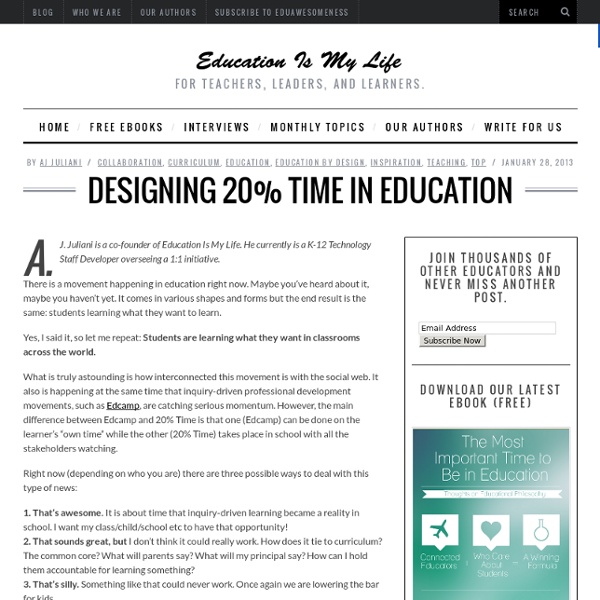Designing 20% Time in Education

20-Time In Education Inspire. Create. Innovate.
Give your students 20% time to do whatever they want | I teach. I think.
"Seriously? You're going to let us do whatever we want for 20% of our time in English class?" "I'm skeptical." "That's awesome." Taking Google's lead, and inspired by Dan Pink's book, Drive, I decided to take the plunge and give my students the kind of radical autonomy they both suggest, and I gave my students 20% of their time in my English class to pursue a project of their choosing. Rules and expectations Project ideas build a tutoring network of high school students helping middle school studentsdesign a complex videogame map using Valve's SDKstart a business selling originally designed t-shirts and accessorieslaunch a web-design start-up for local organizations and businesseswrite a graphic novelmake a stop-motion animated movie of a scene from Macbethwrite a backpacking guide for teenage girlsinterview local senior citizens and document their historyrecord and produce a full-length album Failure is an option Here is a video of clips from their final 20% talks. My own successful failures
The Genius Hour Design Cycle: A Process For Planning -
3. Some students need a push in the right direction Some students will come up with projects that are too simple with answers that could be easily Googled. We introduced the students to ‘High Order Thinking Skills’ and built these into the planning forms students complete. 4. A student might have a passion for surfing and decide they are going to write a book about the history of the sport. 5. It can be hard to say no to a project but some are just not feasible. 6. Some projects will clearly take longer than you have available, others are simply too large in scale or will rely on the involvement of too many people. Creating a detailed timeline with estimates of how long each phase will take is beneficial on many levels at this stage. 7. One of the challenges for some students has been the ever changing project. 8. Over the years we refined the level of planning the students were required to do before commencing on their projects in earnest. 9. 10. 11. 12. 13.
Related:
Related:



